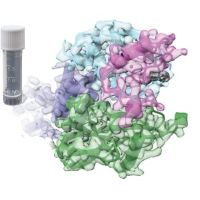Specification
| Description | Recombinant protein from the full-length sequence of Homo sapiens RELB proto-oncogene, NF-kB subunit (RELB) (NM_006509). |
| Organism | Homo sapiens (Human) |
| Expression Host | Human Cells |
| Tag Info | His or DYKDDDDK. Please contact us if you need further information or require specific designed tag. |
| Purity | Greater than 90% by SDS-PAGE gel |
| Uniprot ID | Q01201 |
| Entry Name | RELB_HUMAN |
| Gene Names | RELB |
| Alternative Gene Names | |
| Alternative Protein Names | Transcription factor RelB (I-Rel) |
| Application | Antigens, Western, ELISA and other in vitro binding or in vivo functional assays, and protein-protein interaction studies; For research & development use only! |
| Buffer | Purified protein formulated in a sterile solution of PBS buffer, pH7.2, without any preservatives |
| Endotoxin | Endotoxin level is < 0.1 ng/µg of protein (<1EU /µg) |
| Length | 579 |
| Molecular Weight(Da) | 62134 |
| Protein Sequence | (The sequence of expressed protein may have some variation from the sequence shown below. Please contact us for the exact sequence.) MLRSGPASGPSVPTGRAMPSRRVARPPAAPELGALGSPDLSSLSLAVSRSTDELEIIDEYIKENGFGLDGGQPGPGEGLPRLVSRGAASLSTVTLGPVAPPATPPPWGCPLGRLVSPAPGPGPQPHLVITEQPKQRGMRFRYECEGRSAGSILGESSTEASKTLPAIELRDCGGLREVEVTACLVWKDWPHRVHPHSLVGKDCTDGICRVRLRPHVSPRHSFNNLGIQCVRKKEIEAAIERKIQLGIDPYNAGSLKNHQEVDMNVVRICFQASYRDQQGQMRRMDPVLSEPVYDKKSTNTSELRICRINKESGPCTGGEELYLLCDKVQKEDISVVFSRASWEGRADFSQADVHRQIAIVFKTPPYEDLEIVEPVTVNVFLQRLTDGVCSEPLPFTYLPRDHDSYGVDKKRKRGMPDVLGELNSSDPHGIESKRRKKKPAILDHFLPNHGSGPFLPPSALLPDPDFFSGTVSLPGLEPPGGPDLLDDGFAYDPTAPTLFTMLDLLPPAPPHASAVVCSGGAGAVVGETPGPEPLTLDSYQAPGPGDGGTASLVGSNMFPNHYREAAFGGGLLSPGPEAT |
Background
| Function | FUNCTION: NF-kappa-B is a pleiotropic transcription factor which is present in almost all cell types and is involved in many biological processed such as inflammation, immunity, differentiation, cell growth, tumorigenesis and apoptosis. NF-kappa-B is a homo- or heterodimeric complex formed by the Rel-like domain-containing proteins RELA/p65, RELB, NFKB1/p105, NFKB1/p50, REL and NFKB2/p52. The dimers bind at kappa-B sites in the DNA of their target genes and the individual dimers have distinct preferences for different kappa-B sites that they can bind with distinguishable affinity and specificity. Different dimer combinations act as transcriptional activators or repressors, respectively. NF-kappa-B is controlled by various mechanisms of post-translational modification and subcellular compartmentalization as well as by interactions with other cofactors or corepressors. NF-kappa-B complexes are held in the cytoplasm in an inactive state complexed with members of the NF-kappa-B inhibitor (I-kappa-B) family. In a conventional activation pathway, I-kappa-B is phosphorylated by I-kappa-B kinases (IKKs) in response to different activators, subsequently degraded thus liberating the active NF-kappa-B complex which translocates to the nucleus. NF-kappa-B heterodimeric RelB-p50 and RelB-p52 complexes are transcriptional activators. RELB neither associates with DNA nor with RELA/p65 or REL. Stimulates promoter activity in the presence of NFKB2/p49. As a member of the NUPR1/RELB/IER3 survival pathway, may provide pancreatic ductal adenocarcinoma with remarkable resistance to cell stress, such as starvation or gemcitabine treatment. Regulates the circadian clock by repressing the transcriptional activator activity of the CLOCK-ARNTL/BMAL1 heterodimer in a CRY1/CRY2 independent manner. Increased repression of the heterodimer is seen in the presence of NFKB2/p52. Is required for both T and B lymphocyte maturation and function (PubMed:26385063). {ECO:0000269|PubMed:1732739, ECO:0000269|PubMed:22565310, ECO:0000269|PubMed:26385063, ECO:0000269|PubMed:7925301, ECO:0000269|PubMed:8441398}. |
| Pathway | |
| Protein Families | |
| Tissue Specificity |
QC Data
| Note | Please contact us for QC Data |
| Product Image (Reference Only) |  |

